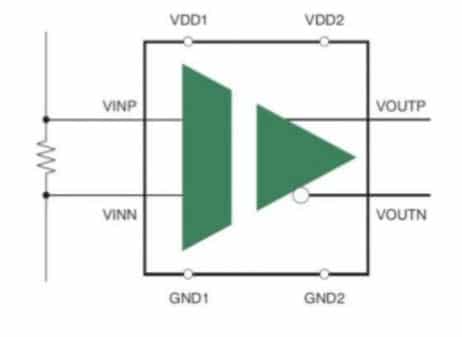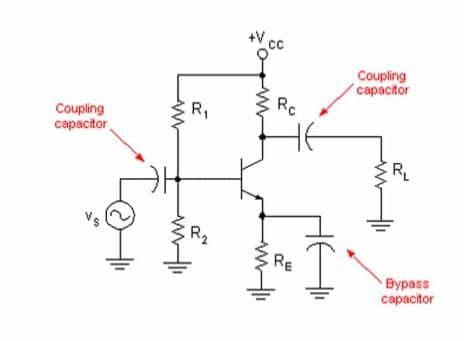An isolation amplifier is fundamentally used to reduce the common voltage between the source side and the power load side. They provide electrical isolation and acts as electrical safety barriers. They are also used to protect the operators from leakage currents. These are some of the most frequently used devices. They work fundamentally on the operational amplifier principle (OP-AMP). Due to their versatility, they find numerous applications in both industry and other major fields like aircraft engineering, aviation, space aircraft, etc. They also used to break the ohmic continuity of electrical signals between input and output signals. Isolated power supplies are provided for both input and output stages. They are also used to amplify low signals.
What is an Isolation Amplifier?
An isolation amplifier, as the name suggests is used to isolate two parts of a circuit and provide amplification to low power signals. Their first major principle is to provide isolation between two parts of a circuit. They provide isolation from the source side to load side, such that there is no direct connection between the two. With this, they act as a safety barrier to the user on the power side. With such isolation, it creates a possibility for high current to pass through both sides. As this high current is isolated to the user, we can say that there is a break in the ohmic continuity of electrical signals between input and output. Since the ohmic continuity is discontinued, we say that the resistance is infinity. As the resistance of the open circuit is infinity and the short circuit is zero. Hence isolation amplifier also provides infinite resistance.

Isolation Amplifier
Another major application is to provide amplification to low-level signals. This application is very important in space applications where the generated signal strength is low. This becomes mandatory as most of the devices are low power level equipment to reduce the weight of the aircraft. The circuit shown below is the pin configuration for the Isolation amplifier.

Pin Configuration
The input part consists of a voltage divider circuit, with VINP and VOUTP as the input and output ports for power. Similarly, we have two ports for ground GND1 and GND2. As shown in the figure, we have two parts, one is the power source part and the other is the load part. A gap between resembles the isolation between the two. As we have seen the isolation amplifier provides isolation. The other two ports, VDD1 and VDD2 imply the ports for the voltage divider circuit respectively. The ports VINN and VOUTN imply the ports for input voltage and output voltage respectively. Overall the pin configuration of the isolation amplifier consists of 8 pins.
Isolation Amplifier Design Methods
There are basically three types of amplifier design methods followed
- Transformer Isolation
- Optical Isolation
- Capacitive Isolation
Transformer Isolation
This is one of the most commonly used isolation amplifier circuits. As shown in the figure, in the primary part of the transformer, an operational amplifier, rectifier circuit, and half of the isolation amplifier are connected. Similarly, on the secondary side, we have a power supply and oscillator circuit connected.
The rectifier which is connected on the primary side converts AC to DC and supplies power to the operational amplifier. The transformer is also known as a magnetically coupled and electrically isolated device. That means that it provides isolation between primary and secondary. Since the two operational amplifiers are connected on primary and secondary, isolation is obtained by using the property of the transformer.

Transformer Coupled Isolation Amplifier
We also know that a secondary emf is induced on the secondary terminals of the transformer due to the magnetic induction principle. The secondary emf voltage is fed to the oscillator circuit which further feeds to a power supply as shown in the figure. Hence by this method, the transformer-coupled isolation transformer operates. The transformer turns ratio is unity in this case, as we don’t want any step up or step down of the voltage. The transformer acts as an isolation transformer. Additionally, the transformer-coupled amplifier uses a frequency-modulated or pulse width modulated signal as a source. The operating frequency of the oscillator is about 20 kHz and a low pass filter is used to eliminate the other frequency components.
Advantages
The advantages of transformer-coupled isolation amplifier include the following.
- The advantages of the transformer-coupled amplifier are the following.
- High Common mode rejection ratio. Its high common-mode rejection ratio makes it a more useful and efficient circuit.
- High Linearity. Even in the presence of a transformer, the linearity of the circuit is high. It gives a linear relationship between input and output.
- High Accuracy. Due to the efficiency of the transformer, its accuracy is high.
Applications
The applications of transformer-coupled isolation amplifiers include the following.
- Medical. For patient monitoring and diagnostic information.
- Industrial. It is used for ground loop elimination and off-the-ground signal measurement.
- Nuclear. For input and output power isolation.
Optically Isolated Amplifier
This circuit consist of a modulator decoder, LED Driver, and clock detector as shown in the figure. The isolation provided in this circuit is in an optimal manner. For optical isolation, photodiodes are used. As shown in the figure, the LED driver after taking the signal from the modulator, given the signal to the photodiode. The photodiode is works based on light intensity and hence no need for transmission through wires. The photodiodes on both sides of the LED driver and decoder convey the signal. It can be seen that the encoder, LED driver, decoder and clock detector form a closed path for the signals to flow via optical isolation. Hence, this isolated amplifier design is based on photodiodes.

Optically Isolated Amplifier
Features of Optical Isolation Amplifier
The features of the optical isolation amplifier include the following.
- The biological signal is converted into a light signal by LED for further process
- It can be battery-driven.
- The input circuit converts the signal to light and the output signal converts the light back to signal.
Advantages
The advantages of the optical isolation amplifier include the following.
- In this circuit, original frequency and amplitude are obtained.
- Its linearity is very high
- As compared to transformer isolation, no modulator or demodulator is required as the coupling is done by optical.
- When we used such circuits in medical appliances, it increases the patient’s safety.
Applications of Optical Isolation Amplifier
The applications of the optical isolation amplifier include the following.
- Industrial Process Control
- Data Acquisition
- Interface element
- Biomedical instruments
- Patient Monitoring
- Test equipment
- Current Shunt measurement
- Ground loop elimination
- SCR Controls
Capacitive Coupled Amplifiers
The capacitor has also the property of coupling and isolating. As shown in the figure it can be used as a coupling capacitor, bypass capacitor, and isolating capacitor. The capacitive isolation is obtained between modulator and demodulator blocks. It uses digital encoding of the input voltage and frequency modulation.

Capacitive Coupling
Features
- It uses digital encoding of the input voltage and frequency modulation.
- It has modulator and demodulator circuits.
- The signals for the circuit are sent across a differential capacitive barrier.
- Separate supplies are given for both sides.
Advantages of the Capacitive Isolation are
- In this circuit, ripple noises are removed
- It avoids device noise, radiated noise, and conducted noise
- It is highly immune to magnetic noises
- It is useful for analog systems
- It has high gain stability and linearity.
Applications of Capacitive Isolation
This circuit has a number of applications. A few of them have been mentioned below:
- It is used for data acquisition
- It is used as an interface element
- It is used in medical applications like a patient monitoring
- Also in ECG and EEG
Know more about FET MCQs.
Hence we have seen an overview of an isolation amplifier, working principles, isolation methods, advantages, disadvantages, and features. The isolation is often provided by a medium. The isolation provided often becomes important for vital applications like medical, etc. We have discussed the mediums to be transformer(magnetic field), light, and capacitive isolation. It is interesting to think about, do we have any other methods of isolation?